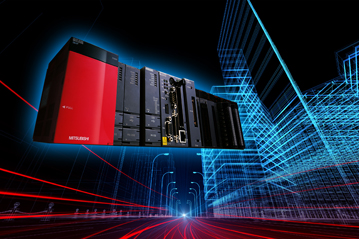Change defines the world. The current challenges faced by society range from the demographic shift to a growing scarcity of natural resources. Automation, too, is changing: future trends in control technology suggest that the role of that control technology will change. Total solutions in which tasks are distributed according to free capacity are growing in importance. The individual components are irrelevant to the customer. Added to this is the debate pitching PLC against PC. The experts at Mitsubishi Electric believe in the coexistence of both systems and already offer flexible, future-ready solutions with the MELSEC iQ Platform and the C Controller.
To bring systems to market more quickly and effectively calls for a structured approach to mechanical engineering, from the profile of requirements to the validation process. Automation suppliers like Mitsubishi Electric are supplying fewer and fewer individual components such as PLCs, inverters or motion controllers. Instead, they are supporting their customers with solutions developed especially to suit the customer’s tasks. “What counts is the overall performance of the system, not the individual performance of the components,” explains Harald Voigt, PLC / HMI / Software product manager at Mitsubishi Electric Europe. “It is important to the customer that the machine carries out the production tasks smoothly. The result of this is that the processors built into the system have to take on a wide variety of tasks flexibly. Therefore, the PLC will no longer exist as such in its familiar form in the future.”
Other single solutions such as motion or robot controllers will play a different role in future automation systems too. Harald Voigt explains: “The customer will simply be able to describe a problem via software and define a solution. It is not important to the customer which processor is used to execute the task, whether it’s a PLC, motion controller, robot or inverter. This decision is made autonomously by the increasingly intelligent automation environment and according to free capacity, regardless of the nature of the task. All relevant components, from the redundant high-performance controller to the sensor, communicate in real time with one another according to the principle of distributed intelligence.”
System deployment to suit the requirements
The PLC supports communication in real time. “A Windows-based system may be distinguished by its high speed and capacity, but it isn’t a real-time operating system,” continues Harald Voigt. The PLC is also comparatively secure, because it has much greater protection against unauthorised access from outside. In addition, it supports the longer life cycles of systems as well as being able to execute different tasks. This flexible capability is increasingly important, because strategic standards such as IEC61499, which covers function blocks for industrial control systems and guidelines for distributed intelligence in control systems, are becoming increasingly important.
The question is, which system type will prevail in the long term? “Both systems will continue to exist and be used depending on the user requirement,” says Harald Voigt confidently. “In a combination of intelligent systems, the PLC assumes responsibility for all sequences that have to be particularly safeguarded.”
Solutions for the future
Mitsubishi Electric already offers an automation platform by means of which all processors can be connected to one another with the MELSEC iQ Platform. Due to this, only a single PC is required to set parameters for the entire machine. Using Mitsubishi Electric’s MELSOFT software, various components such as inverters, robots, HMIs, PLCs or motion controllers can be programmed via the iQ Platform. Simulation functions also ensure a shorter introduction time for the system.
In addition the C Controller from Mitsubishi Electric also offers an open platform for customers, for example it already supports a diverse range of solutions such as C Batch, C Connector, MES IT, LUA, CoDeSys, ECO Web Server III or C NET DB, from setting parameters via positioning to the integration of communications standards. “With these products we can follow and shape the change in automation technology smoothly,” says Harald Voigt.
[info] www.mitsubishi-automation.com [/info]

